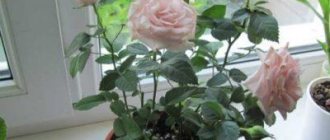A rare flower does not have its own history, full of legends and superstitions. The stone rose, often used in landscape design, is no exception. How to care for it at home?
Stone rose is an exclusively popular name used in Russia and the CIS countries
Botanical description of stone rose (juvenile)
Stone rose is an exclusively popular name used in Russia and the CIS countries. tenacious or hare cabbage, echeveria is also used Translated from Latin as “always alive.”
This unusual succulent consists of many lanceolate, succulent leaves that look like scales. They are located around a straight stem in the form of large or small rosettes (in diameter from 1 to 15 cm in diameter). Star-shaped flowers with a double perianth and many stamens ripen into ovoid fruits from 8 to 20 pieces.
Looking carefully at the plant, you understand why it was named so. Its pattern of leaves resembles a blossoming rose. Often found in the Caucasus and southern North America.
Propagation of echeveria by rosettes
- cut off the basal or apical rosette (use a sharp, clean tool);
- remove a row of lower leaves;
- dry for 3-4 hours in the shade;
- pour the prepared substrate into the pot (soil + small stones, coarse sand - 1:1). It is advisable to lay a drainage layer of small pebbles or expanded clay at the bottom;
- plant a rosette of echeveria, lightly moisten the soil;
- maintain the temperature around 22 – 24 ˚ C;
- You will have to wait about a month for rooting;
- grow young echeveria from a rosette in the same pot for 2 months to a year.
Signs and superstitions associated with the stone rose
Echevaria has a rather controversial reputation: some believe that the plant does not carry negative emotions, others are afraid to plant hare cabbage at home or in the garden, because they believe in its negative energy. It must be said that the second superstition arose due to the fact that stone roses are often planted in cemeteries. This choice is not surprising, the plant is practically unpretentious, it thrives on stones, it does not need to be watered often, it survives drought calmly and at the same time looks great. But, like any other living creature, the survivor is capable of absorbing bad emotions (but also positive ones).
We also recommend reading:
16 most popular indoor plants Physalis: description of species and varieties, technology for growing from seeds Spruce in landscape design: the best ornamental varieties and characteristics of cultivation Kalanchoe: description of types and characteristics of care at home
And so the plant has had a good reputation since Antiquity. In Ancient Rome, the flower was called a talisman; they believed that it could ward off evil from its owner. This superstition was not forgotten in the later era of the Early Middle Ages: Charlemagne ordered it to be planted on the roofs of houses to “scare off” lightning. So the stone rose became the first “lightning rod”.
There is no need to be afraid of keeping a flower at home because of existing superstitions. In order for him to “cleanse” himself of accumulated negativity, it is enough to simply talk to him often and treat him with love. Then the stone rose will only be a joy; it will become a true decoration for the room.
Echevaria has a rather controversial reputation: some believe that the plant does not carry negative emotions, others are afraid to plant hare cabbage at home or in the garden, because they believe in its negative energy
Conditions of detention
“Stone Rose” loves the sun and bright, preferably diffused light. Only in the midday heat should the plant be shaded. When there is not enough light, the young ones stretch out, the leaves turn pale, and the flower loses its decorative qualities. Therefore, it is advisable to place the pot with it on the windowsill of a window facing south. In summer it can be taken out onto the balcony or open veranda.
Secrets of caring for a stone rose in the garden
Any garden flowers need to be carefully looked after, only then will they be able to develop properly. And although the survivor is not too whimsical, it is also demanding of certain factors and they should be taken into account.
- The peculiarity of succulents is that they perfectly accumulate water and are able to survive long periods of dry soil without any problems. Therefore, you do not need to water the plant every day, but once or three times a week during particularly hot months. Do not overdo it, otherwise the roots will begin to rot, which almost always leads to death. Keep an eye on the lower leaves, they are the ones who begin to respond to overflow first.
- Carry out the process itself under the plant, the outlet should not be wet.
- Loosening the soil around the crop has the most beneficial effect on it. This helps get rid of weeds, the roots begin to breathe better, and ventilation increases, which prevents moisture accumulation. But keep in mind that the rhizome is almost on the surface, so carry out the process extremely carefully.
- Remove dead plants and weeds in a timely manner.
- What attracts gardeners to the stone rose? It does not need to be fertilized, unlike many other crops. Fertilizing worsens the saturation of the leaves and makes the plant more vulnerable to frost. Only three-year-old flowers need help. Buy a special preparation for succulents and cacti, use only half the volume of the indicated dose.
Light-loving stone roses must be prepared for cold weather. Delicate and delicate flowers will simply die in the first winter. The process itself is not too complicated.
- Prepare shelter. Plastic bottles with a volume of 5 liters are perfect for protection. Cut off the top of them.
- Punch holes with an awl 1 cm from the cut. There shouldn’t be too many of them; five to seven pieces is enough.
- If such a bottle is too large, select another container that is suitable in width. If one container is not enough, then take several pieces.
- Turn the vessel upside down and place it above the flower bed. To prevent it from being blown away by the wind, secure the bottle with metal rivets or pins. That's what the holes are for.
- Carefully cover the one-year-old juveniles with spruce branches, and they will survive their first winter in an open area just fine.
Echeveria leaf propagation
How to propagate echeveria from leaves photo
The succulent reproduces by leaf without any problems, and the process does not present any particular difficulties.
Root the echeveria leaf in the soil mixture:
- you need to break off the lower healthy leaf;
- dry for 2-3 hours;
- soil mixture (earth to sand 2:1), perlite on top (2 mm), poured into a container;
- press the sheet at an angle;
- spray the soil with a spray bottle and cover the container with film;
- the greenhouse should be ventilated daily and moistened as the top layer of soil dries,
- the optimal temperature for rooting is 25 degrees Celsius;
- after 15-20 days, babies will grow around the leaf;
- a new plant can be replanted when the mother leaf dries out.
Surprisingly, propagating echeveria by leaf can be even easier:
- separate the bottom large, fat leaf;
- place in a warm, shaded place;
- you should calmly wait about a month (+/-);
- roots and small rosettes will appear on the leaf;
- after which the young plants should be planted in a pot.
You have to be prepared for surprises, because on one leaf several children will develop, but on another there will be none (and this happens). Experiment to see which way you like best will give better results.
Gallery: stone rose flower (56 photos)
Methods for propagating stone roses
Most people are afraid to purchase several specimens at once, but then they realize the value and beauty of these plants and think about buying a few more succulents. But the tenacious creature reproduces easily, so you don’t have to resort to store services and try to get new stone roses yourself.
There are several methods of propagation: seeds, cuttings or leaves.
Vegetative (cuttings or leaves)
- Choose the healthiest and most beautiful succulent in your flower bed. Separate from it the leaf located closer to the trunk. He shouldn't be too young.
- Or cut off the top of the bush, tearing off the lowest leaves.
- Dry the workpieces for several hours.
- At this time, mix vermiculite and sand in equal proportions. Moisturize it.
- Stick the cutting or leaf into the prepared soil and place it in a well-ventilated and sunny place.
- So the plant should stand for a month. Moisten the soil periodically.
- During these 30 days, in good conditions, an outlet should appear. It will take 2 to 3 months for its final formation. The maternal part will dry out at this time.
- Transplant the new organism into a separate pot with cactus soil.
Seeds
- For this method you will need peat and sand. Place their mixture in a suitable box.
- Stick the seeds shallowly into the ground (4-5 mm). Spray the soil with a spray bottle. Cover everything with film.
- The container is left in a warm (20-25 degrees) and lighted room.
- Moisten the soil as needed.
- After two weeks, the succulents will appear above the ground, and the young ones are transplanted when 2-3 well-developed leaves are formed.
Rose blossoms at home and outdoors
At home, to obtain flowers in July-August, it is necessary to provide the plant with a cool winter. It is enough to lower the temperature to 10 °C. And if the temperature on the balcony does not drop below −20 °C, then this is where the pot should be taken in October and left there until April.
Young offspring flower
Period of activity and rest
The dormant period begins for the young when the air temperature drops below 10 °C. At this time, the plant freezes. If the succulent is kept at this temperature from autumn to spring, then the formed flower buds will bloom next summer.
Care during and after flowering
The plant does not need any special care either when setting buds or after flowering.
Important! Peduncles are removed after wilting to restore a neat appearance and not force the plant to waste energy on ripening the seeds.
What to do if it doesn't bloom
The absence of flower stalks in July-August is due to two reasons:
- winter is too warm. If you leave the pot to overwinter at a temperature of 20 ° C or higher, the flower buds will not form. The plant will put all its energy into new shoots and rosettes;
- For some species, flowering is typical only 3 years after sowing, while others do not bloom every year. Information should be clarified in a botanical reference book.
Options for using stone roses in landscape design
Succulents can pleasantly diversify the look of a garden, adding zest and some warmth to it. The uniqueness of the plant lies in the fact that it is very beautiful, but at the same time it has a green or burgundy tint that is pleasant to the eye. It’s hard to overdo them, so they can be used in absolutely any volume.
- As already mentioned, echveria does not combine well with other flowers due to the fact that it does not receive enough light. Therefore, you need to carefully select other crops. It’s better to do without them, the stone rose is already quite original.
- The combination of pebbles (decorative stones) and hare cabbage is the most impressive. Tender and succulent succulents look very beautiful together with neutral and harsh gray-brown tones. Therefore, if you doubt your abilities as a decorator, choose young ones. It requires very little effort and material, and the result will be wonderful.
- Stone roses look great in individual pots. There is absolutely no need to buy new ones! Broken or outdated containers will do, as long as they are well cleaned. For beauty, you can paint “patches” in especially worn places. Place it on the ground side up and let your imagination run wild! Gardeners even use old shoes, and succulents look great in them.
Stone rose goes well in any composition. They can be used with anything (as long as they follow the prescribed rules).
Stone rose goes well in any composition
Diseases and pests rejuvenated
The plant has high immunity, so they most often get sick due to improper care. There are also insects that can cause great harm to them. The most common health problems:
- Rotting of roots and rosettes. The reason is waterlogging of the soil. You can detect that putrefactive processes have begun by looking at the lower leaves. Sometimes the young becomes transparent and then turns brown. The affected parts are cut out, the flower is disinfected, and then replanted in new soil. If the disease has affected the root system, the plant should be replanted so that rot does not affect healthy specimens.
- Weeds, growing between the rosettes, take nutrients and moisture from the soil from the succulent. If there is too much weed, it will shade the young plants, which will negatively affect their decorative appearance. Therefore, weeding is done regularly.
- A dangerous pest for sempervivums is the cockchafer, or rather its larvae (Article about the larvae of the chafer). They eat leaves, making long passages through them. If damaged, the flower is transplanted into another flowerbed, and the soil where it grew is treated with chemicals against insects.
- Birds also harm the young: magpies, jays, crows. They feast on stems and leaves. They are fought with the help of special preparations or plants are planted that repel birds.
If you properly care for a stone rose, you can grow huge rosettes or get a carpet of small flowers in your flowerbed. Among the stones of the rakalia or alpine hill, the juvenile looks very impressive.
Features of growing stone roses at home
Juveniles are also excellent for home growing. It should be remembered that in indoor conditions the flower takes root very well, but after that it can no longer be transplanted to an open area, as it simply will not take root.
In principle, the rules of care do not really change:
- Choose exclusively southern sides so that the survivor can receive enough sunlight every day. Even on western and eastern windows there will be a shortage, and on northern windows the succulent will completely wither.
- If you want his plant, but you don’t have enough sun at home, then build a source of additional lighting.
- Juveniles need to be watered very rarely. Just two or three times in the winter months and once a week in the summer is enough.
- Don't think there isn't enough moisture. It is more dangerous to overwater a flower than to underwater it, since it tolerates drought very well and rarely dies from lack of water.
- Use a mixture of sand, peat or leaf soil as soil. Loosen it carefully from time to time.
Since stone roses are practically not susceptible to pests and diseases, they will appeal to lovers of indoor plants. Weeds and cockchafers do not threaten them, the main thing is not to overwater them so that the root system does not rot.
How to care after planting
Climbing rose: planting and care in open ground
There are a number of features that a stone rose has when planting and caring for it in open ground.
Carrying out watering work
The young do not require watering or spraying too often - the fleshy leaves contain a certain supply of moisture. Thus, this flower should be watered twice a week when dry weather sets in during the summer season. There is a need for watering only when planting rosettes in the ground.
Watering roses
Watering the plant is carried out using the root method. If water gets into the central part of the outlet, it will cause the planting to rot. When growing a stone flower on a windowsill, water it twice a month, in the summer season - once a month. An excess of liquid manifests itself in the lethargy of the leaves of the lower tier, which subsequently dry out.
How to fertilize the young
Often, poor soil into which no fertilizers have been applied is suitable for the development of juveniles. However, flowering is impossible without the presence of nutrients.
It should be noted! Only three-year-old and older plants can be fertilized. It is permissible to use a mixture for cacti, if you comply with the manufacturing conditions of a concentration that is two times weaker than recommended in the instructions.
When there is an excess of fertilizers, the appearance of the flower becomes deformed, which is expressed in the lengthening and disintegration of the rosette, lightening of the leaves and loss of decorativeness. Fertilization, like watering, is carried out rarely. First of all, the soil is spilled with clean water, after which liquid mineral essence is added - this will prevent burning of the root system.
How to care when growing in a pot
The young are suitable for growing on a home windowsill. To make the composition more decorative, a certain number of different rosettes are planted in one planting pot. A domestic rose does not require excessive care, just like one grown in open ground.
The bottom of the landing tank is filled with drainage, one third of it is filled with an expanded clay layer. You can use an unenriched substrate intended for cacti by adding pieces of coal to it, which will absorb excess liquid. Indoor juveniles do not need frequent watering.
Note. In the winter season, it is recommended to place this beautiful flower on an indoor balcony for wintering.
Winter care in open ground
Until winter ends, open ground conditions are quite suitable for growing young. The only condition is to prevent liquid from entering the central part of the outlet in varieties for decorative purposes. This can be done by covering a garden flower with polyethylene or a shortened plastic bottle, as well as spruce branches. Any covering material must be secured in case of strong gusts of wind.
Young plants planted at the end of summer also need to be covered. If there are a small number of rosettes, you can dig them up for wintering, and with the onset of the spring season, plant them again in the garden plot.
It should be noted! There are a number of varieties that are unable to withstand wintering. If their planting location is outdoors, they should be moved to indoor planting containers.











